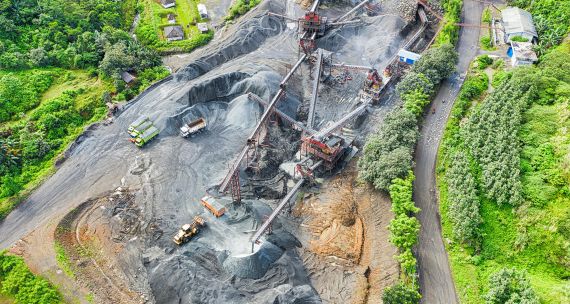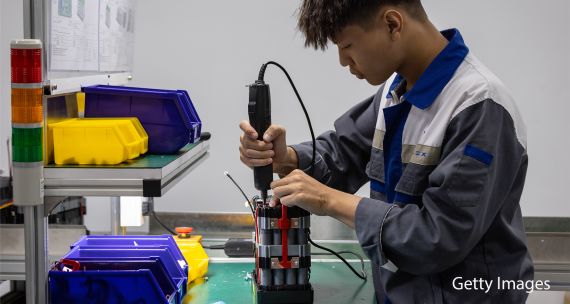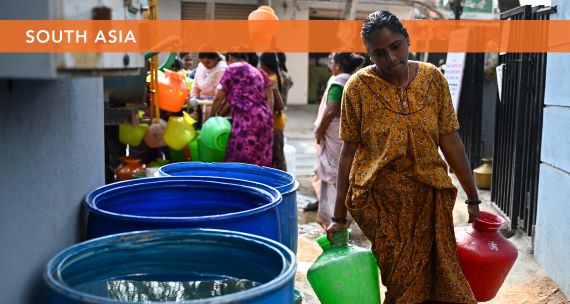In Summary
The importance of the Global Biodiversity Framework to Southeast Asia cannot be emphasized enough. Especially as the region hosts some of the planet’s richest biodiversity, addressing nature loss is increasingly urgent and requires a multi-stakeholder approach – including sustainable infrastructure, efficient financial capacity, and urgent policy changes. Does the region have the capacity to step up to the challenge?
Introduction
In the early hours of December 19, 2022, in Montreal, Quebec, the text of the Kunming-Montreal Global Biodiversity Framework (GBF) was finalized, with more than 190 signatory states agreeing to protect 30 per cent of the lands and waters on earth, cut global food waste in half, and mobilize at least C$272 billion annually in global biodiversity funding by 2030, among other goals.
Negotiations at the 15th Conference of Parties (COP15) to the UN Convention on Biological Diversity (CBD) – cohosted by Canada and China – were fraught with disagreements, deadlocks, walkouts, and protests. Insufficient and inefficient financial aid disbursement and the disjuncture between the expectations of developed nations and the capacity of developing states to implement the agreement were some key issues that surfaced during the negotiations. Ultimately, the agreement was struck, a non-binding voluntary instrument meant to set conservation targets for the end of this decade.
For Southeast Asia, the GBF could not have come sooner. The region is home to wetlands, tropical rainforests, peatlands, coral reefs, mangroves, and river deltas, some of the planet’s richest biodiversity at risk from virtually every possible environmental threat – from climate change and rising sea levels to deforestation and destructive resource extraction. As a result of these threats, the region is at risk of suffering significant environmental, economic, and social losses. But for the GBF to succeed in the mitigation of these risks and for the protection of biodiversity in Southeast Asia, several key policies need to be implemented.
Background
As of 2021, only 16.6 per cent of terrestrial and 7.7 per cent of marine areas globally were under conservation. The World Economic Forum (WEF) Global Risks Report 2023 ranks “biodiversity loss and ecosystem collapse” as the fourth most severe risk to economies and societies for the next decade, a risk amplified in biodiversity-rich Southeast Asia. According to the WEF, anthropogenic extinction, the extinction of species due to human activity, has been occurring one thousand times faster than the natural rate – threatening one million flora and fauna species globally. This accelerated extinction rate is predicted by the WEF to result in a loss of natural capital that could put 63 per cent of the Asia Pacific region’s gross domestic product at risk. In Southeast Asia, up to 42 per cent of biodiversity could vanish by the end of this century.
The GBF is being hailed as a landmark ‘Paris Agreement for nature’ to protect and restore global biodiversity. With 23 targets to be met by 2030 and four broader goals to be achieved by 2050, the framework is intended to be incorporated into national, sector-level plans while also taking into consideration varying domestic circumstances. Protecting 30 per cent of the world’s land and ocean by 2030 (also known as ‘30x30’) is the central ambition of the GBF, and it takes a bottom-up approach in its implementation. Parties to the CBD are required to submit National Biodiversity Strategies and Action Plans (NBSAPs). The onus is on countries to ensure NBSAPs and domestic policies support the GBF’s 18 considerations, which include the “role of Indigenous Peoples and local communities as custodians of biodiversity,” “national circumstances, priorities and capabilities,” a “human rights-based approach,” and “ensuring gender equality.” Several financial targets were also set to build capacity to meet the GBF targets. One is the pledge to domestically mobilize at least US$200 billion annually in public and private financing to implement NBSAPs by 2030.
But the challenges for the region to meet its targets under the GBF are immense. For example, it should be noted that none of the Southeast Asian states met all 20 targets in the GBF’s predecessor, the Aichi Biodiversity Targets for 2010-2020. Most Asian countries were unable to meet the key protected areas targets under Aichi, where countries had to commit to protecting at least 17 per cent of terrestrial land and inland waters and 10 per cent of coastal and marine areas by 2020. In fact, Asia was ultimately the most “underperforming continent globally with just 13.2 per cent of terrestrial protected area coverage.” This raises concerns for the ambitious 30 per cent target now committed under the GBF, which for Southeast Asia means protected-area growth will need to accelerate 2.4 times faster than it is today.
Perspectives from Southeast Asia
Southeast Asia houses almost one-fifth of the planet’s plant and animal species, one-third of coastal and marine habitats, one-third of the world’s coral reef species, more than half of tropical peatlands, and almost half of the world’s mangrove areas – despite only occupying three per cent of the planet’s total land area.
Three of the world’s 17 ‘megadiverse’ countries are in Southeast Asia – Indonesia, Malaysia, and the Philippines – countries that have the highest species diversity and endemism per unit area. Adding to the region’s rich biodiversity is the Indo-Burma Biodiversity Hotspot comprising the Greater Mekong countries – Cambodia, Lao PDR, Myanmar, Thailand, and Vietnam. And this biodiversity has yet to be fully catalogued. In 2020 alone, 224 plant and vertebrate species were discovered within this hotspot.
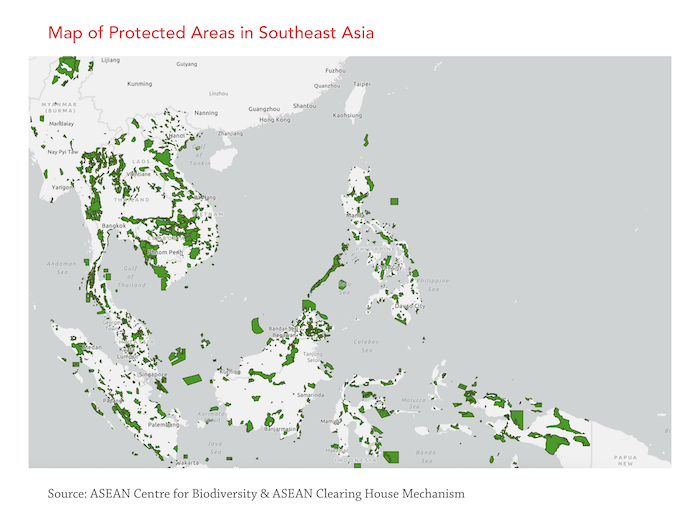
More broadly, Southeast Asia – a region with the highest risk of species extinction and ecosystem collapse – finds its situation exacerbated not only by the accelerating climate crisis but also by unsustainable industrial and agricultural practices and rapid development and urbanization. More than 660 million people depend on the region’s biodiversity for their livelihoods and welfare, but only six per cent of Southeast Asia is under conservation. Meanwhile, land conversion for agriculture, human settlement, and timber products has resulted in a loss of some 80,000 square km of forest cover annually. The critical drivers threatening Southeast Asia’s biodiversity include land and sea use change, pollution, species overexploitation, climate change, invasive species, and disease. The link between deforestation and pandemics is clear, placing Southeast Asia at risk of being the next ground zero of a pandemic if natural habitats continue to be destroyed at these unprecedented rates.
Urbanization in Southeast Asia is expected to intensify, with the population projected to grow by another 100 million people by 2030. With this growth comes an urgent need for sustainable infrastructure that addresses both urban biodiversity and reduces the stress on existing ecosystems. Gone is the rhetoric that nature will inevitably be collateral damage in economic development; studies have shown how biodiversity conservation can generate wealth and economic opportunities across the region – of nearly C$3 trillion annually. The Asian Development Bank (ADB) has raised its climate finance ambition for 2019-2030 to C$134 billion. It has also called for private sector finance to be mobilized and for Southeast Asian states to integrate green, social, and sustainable bonds into their respective financial frameworks to finance green infrastructure.
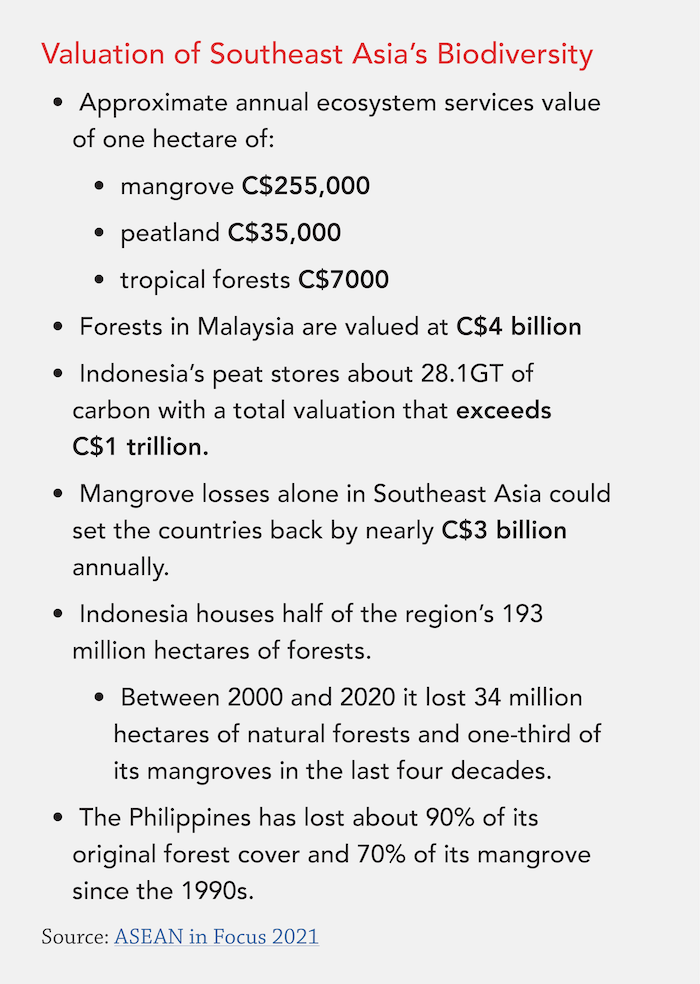
As the region grows and increasingly urbanizes, efficient disbursement of financial resources will be critical. With the GBF, the responsibility is now at national levels to implement the framework, which will take more than just political will. The private sector must play a central role in facilitating financing and capacity provision. Building financial, institutional, infrastructural, and technical capacities across communities and industries is paramount to the GBF’s success in Southeast Asia, as is embedding nature-positive criteria into decision-making processes across different sectors.
For the 30X30 target to be met, efforts at the state level would need to be buttressed by the private sector. A record number of private companies attended COP15, with more than 330 companies and investors calling for a stronger and mandatory GBF. Many were engaged in side events while the negotiations were taking place, and several businesses and consortiums pledged finance and technical capacity for the GBF targets to be met, including the C$400-million Climate Fund for Nature by Kering and L’Occitane. Outside COP15, similarly, the private sector has increasingly been stepping up to address the biodiversity crisis, including Singapore-based companies Silverstrand Capital and Ecoshare. The former has launched an accelerator program supporting companies working in nature technology and nature-based solutions, while the latter sustainably manages ecosystem assets on behalf of landowners in Papua New Guinea. Similarly, investment firm Terratai recently launched in Indonesia to meet the financial and technical gaps for conservation startups. These are the type of private sector initiatives needed to meet the GBF targets.
Urgent policy changes are also key to meeting the GBF targets, policies that include and respect Indigenous and local communities in biodiversity conservation. Meeting the targets necessitates a just transition rooted in a rights-based approach prioritizing inclusivity – much like the approach laid out in the Just Energy Transition Partnerships (JEPTs) that were struck in recent years with Indonesia and Vietnam.
Additionally, in transitioning to a nature-positive planet, research has shown how investments in Nature-based Solutions (NbS) can generate significant employment opportunities, particularly in rural areas. A recent report by the International Labour Organization, UN Environment Program, and the International Union for Conservation of Nature (IUCN) found that most of the 75 million people employed in the NbS sector live across the Asia Pacific region and that 20 million additional jobs could be created if investments in NbS were tripled by 2030. NbS – a climate mitigation and biodiversity conservation approach that can concurrently address both crises – is increasingly gaining traction in the region. The restoration of degraded mangroves, for example, is not only able to sequester carbon and buffer against storm surges, but also conserve biodiversity. In doing so, it is an effective climate mitigation, adaptation, and biodiversity conservation tool. Increasingly, there is a higher premium for NbS-driven carbon credits, and higher demand for these credits could make the carbon market worth at least C$24 billion in annual revenue by 2050.
Along with such solutions, benchmarking and consolidating regional effort are also needed, given the highly transboundary impact of biodiversity losses in the region. The Association of Southeast Asian Nations (ASEAN), in keeping with its core tenet of centrality, issued a joint statement to COP15 following the Global Biodiversity Framework agreement reiterating its commitment to collectively enhancing transboundary co-operation and strengthening capacity while also calling for CBD parties to mainstream biodiversity across various industries, scale up actions to build capacity, and provide resources to help developing countries implement their NBSAPs. Working closely with external partners such as the EU, the Republic of Korea, and Deutsche Gesellschaft für Internationale Zusammenarbeit (GIZ), the German development agency, ASEAN serves as a key node in capacity building in the region.
Looking Ahead
Meeting the GBF targets will take a concerted effort – particularly in a region that is in urgent need of technical, financial, and infrastructural capacity. In 2022, Canada pledged C$350 million to support conservation efforts in developing countries. This is in addition to the C$5.3-billion commitment to international climate finance made in 2021. In providing international environmental assistance, Canada applies a nature-positive screen to all project proposals. The private sector has similarly been increasingly active in advancing sustainable finance. Aside from providing a blended finance approach, Canada can support Southeast Asia’s environmental transition via its technical strengths in carbon capture, sustainable engineering, and nature-based solutions.
Through the CBD and the GEF, Canada has been engaging with Southeast Asia via the G7 and other bilateral initiatives. ASEAN member states collectively, in 2021, represented Canada’s fourth-largest trading partner. The Canada-ASEAN free trade agreement currently under negotiation presents another opportunity to facilitate the region’s low-carbon nature-positive transition through an exchange of technical and financial capacity in sustainable infrastructure and trade of low-carbon goods and services. Strengthening academic exchanges is also crucial to meeting the capacity gaps in implementing and measuring GBF targets. Facilitating business-to-business partnerships could also facilitate improved green technology transfer.
As noted during the Global Biodiversity Framework negotiations in Montreal, targets must be measurable. Aichi, the GBF’s unsuccessful forerunner, was aspirational at best and lacked the financing for developing countries to implement their national strategies. Unless lessons were learned from Aichi, given some of the vague language and the non-binding nature of the GBF, it too might be in danger of going unfulfilled. However, hope lies with the increasing recognition of how interwoven and urgent climate and biodiversity issues are, as observed with yet another landmark conservation agreement – the legally binding UN High Seas Treaty reached in March 2023 by 193 countries seeking to protect 30 per cent of the marine areas beyond national jurisdiction. The treaty, which has the potential to catalyze actions needed to meet the GBF targets, will impact shipping lanes and commercial fisheries, especially in Asia, where more than half of the world’s commercial fishing occurs. The risks associated with inaction on Southeast Asia’s biodiversity are monumental. There are opportunities, however, to effectively mitigate these risks using a nature-positive approach.


